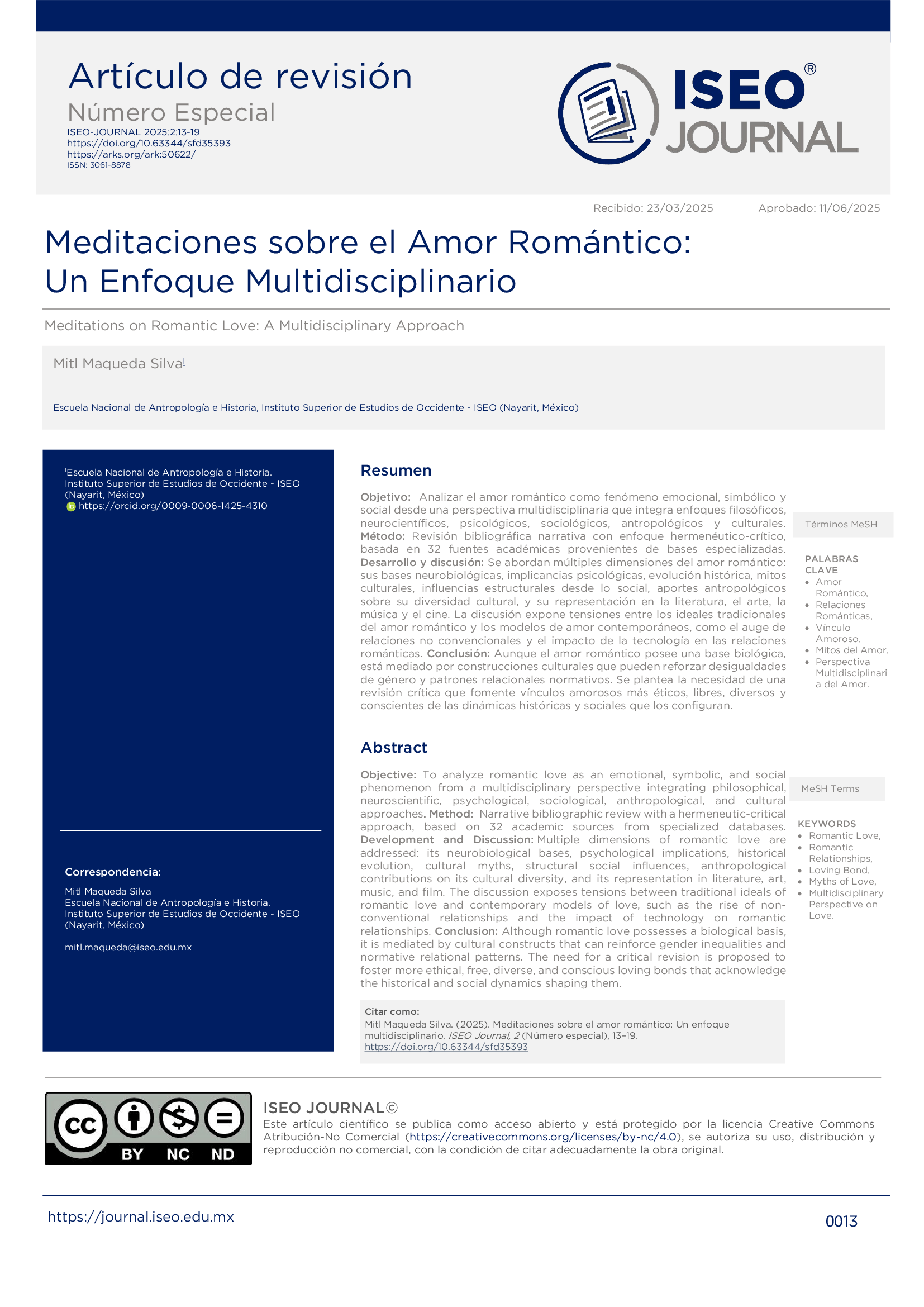
Published 2025-07-31
Keywords
- Romantic Love,
- Romantic Relationships,
- Loving Bond,
- Myths of Love,
- Multidisciplinary Perspective on Love

This work is licensed under a Creative Commons Attribution-NonCommercial-NoDerivatives 4.0 International License.
How to Cite
Abstract
Objective: To analyze romantic love as an emotional, symbolic, and social phenomenon from a multidisciplinary perspective integrating philosophical, neuroscientific, psychological, sociological, anthropological, and cultural approaches. Method: Narrative bibliographic review with a hermeneutic-critical approach, based on 32 academic sources from specialized databases. Development and Discussion: Multiple dimensions of romantic love are addressed: its neurobiological bases, psychological implications, historical evolution, cultural myths, structural social influences, anthropological contributions on its cultural diversity, and its representation in literature, art, music, and film. The discussion exposes tensions between traditional ideals of romantic love and contemporary models of love, such as the rise of non-conventional relationships and the impact of technology on romantic relationships. Conclusion: Although romantic love possesses a biological basis, it is mediated by cultural constructs that can reinforce gender inequalities and normative relational patterns. The need for a critical revision is proposed to foster more ethical, free, diverse, and conscious loving bonds that acknowledge the historical and social dynamics shaping them.
Downloads
References
- Bamford, J. S., Vigl, J., Hämäläinen, M., & Saarikallio, S. H. (2024). Love songs and serenades: A theoretical review of music and romantic relationships. Frontiers in Psychology, 15, Article 1302548. https://doi.org/10.3389/fpsyg.2024.1302548
- Bode, A., & Kushnick, G. (2021). Proximate and ultimate perspectives on romantic love. Frontiers in Psychology, 12, Article 573123. https://doi.org/10.3389/fpsyg.2021.573123
- Bonavitta, P. (2015). El amor en los tiempos de Tinder. Cultura y Representaciones Sociales, 10(19), 163–190. https://www.scielo.org.mx/scielo.php?script=sci_arttext&pid=S2007-81102015000200009
- Cañaveras, P., Lopez de Aguileta, G., Guo, M., Torras-Gómez, E., Crespo-López, A., Menéndez-Martínez, B., Fernández-González, M. del P., Puigvert-Mallart, L., & Flecha, R. (2024). The characteristics versus the “myths” of romantic love. Social and Education History, 13(2), 80–96. https://doi.org/10.17583/hse.14505
- Cervantes Flores, J. G., & Valdez Alejandro, G. (2024). La construcción social del amor en el teatro: Una revisión conceptual, histórica y cultural. Dramaturgia y Escena, 1(1), 56–75. https://doi.org/10.29105/de.v1i1.7
- Ferloni, M., & Nosseinte, L. (2022). Apuntes sobre el amor romántico y la responsabilidad afectiva [PDF]. Mora, 28, Article e8118. http://revistascientificas.filo.uba.ar/index.php/mora/article/view/8118/11301
- Fisher, H. (1994). Anatomía del amor. Anagrama.
- Fromm, E. (2000). El arte de amar. Paidós.
- Calixto, E. (2018). Amor y desamor en el cerebro: descubre la ciencia de la atracción, el sexo y el amor. Aguilar.
- Illouz, E. (2009). El consumo de la utopía romántica: El amor y las contradicciones culturales del capitalismo. Katz editores.
- Eco, U. (1996). La Estrategia de la ilusión. Lumen.
- Flores Fonseca, V. M. (2019). Mecanismos en la construcción del amor romántico. La Ventana: Revista de Estudios de Género, 50, 282–305. https://www.scielo.org.mx/scielo.php?script=sci_arttext&pid=S1405-94362019000200282
- Gibson, L. S. (2023). The science of romantic love: Distinct evolutionary, neural, and hormonal characteristics. International Journal of Undergraduate Research and Creative Activities, 7(1), Article 6. https://doi.org/10.7710/2168-0620.1036
- Gil Gómez, A. M. (2024). Análisis de la evolución y presencia del amor romántico como modelo mental: Mitos, sexo/género y homosexualidad. Revista Científica Arbitrada de la Fundación MenteClara, 9(62), 1246–1264. https://doi.org/10.36576/2660-9525.62.89
- Gómez-López, M., Viejo, C., & Ortega-Ruiz, R. (2019). Well-being and romantic relationships: A systematic review in adolescence and emerging adulthood. International Journal of Environmental Research and Public Health, 16(13), 2415. https://doi.org/10.3390/ijerph16132415
- Guevara Bustamente, A. (2023). Tu príncipe azul es un agresor: La idealización del amor romántico y su influencia en la violencia de género dentro del contexto latinoamericano. https://doi.org/10.18800/lacolmena.202301.007
- Han, Y., Luo, Y., Chen, Z., Gao, N., Song, Y., & Liu, S. (2024, enero 31). A decade of love: Mapping the landscape of romantic love research through bibliometric analysis. Humanities and Social Sciences Communications, 11, Article 26. https://doi.org/10.1057/s41599-024-02665-7
- Kristeva, J. (1987). Historias de amor. Siglo XXI.
- Kowal, M., Bode, A., Koszałkowska, K., Roberts, S. C., Gjoneska, B., & Frederick, D. (2024). Love as a commitment device: Evidence from a cross-cultural study across 90 countries. Human Nature. Advance online publication. https://doi.org/10.1007/s12110-024-09482-6
- Lagarde, M. (2001). Claves feministas para la negociación en el amor. Puntos de Encuentro.
- Le Breton, D. (1999). Las pasiones ordinarias. Antropología de las emociones. Nueva Visión.
- Mead, M. (1961). El hombre y la mujer. Un enfoque revolucionario de las relaciones entre ambos sexos. Fabril Editora.
- Mogrovejo, N. (2025). La colonialidad del amor [PDF]. Periódicus: Revista de Estudos Indisciplinares em Gêneros e Sexualidades, 21(1), 445–461. https://periodicos.ufba.br/index.php/revistaperiodicus/article/download/58668/36950/260563
- Morin, E. (1998). Complejo de amor. Gazeta de Antropología, Nº 14.
- Pasantes, H. (2017). De neuronas, emociones y motivaciones. Fondo de Cultura Económica.
- Pedroza Flores, R. (2015). Los cambios del vínculo amoroso en la posmodernidad [PDF]. RICSH. Revista Iberoamericana de las Ciencias Sociales y Humanísticas, 4(8), 1–16. https://www.redalyc.org/pdf/5039/503950656019.pdf
- Pimenta Lobato, J. (2021). Una antropología del amor: De Oriente a Occidente. Prometeo Libros.
- Platón. (1985). Banquete. Gredos.
- Rivera Alzate, J. D., & Giraldo Doria, M. (2023). Del amor romántico al amor libre: Configuraciones del amor en las relaciones no monógamas. Poiésis, (45). https://doi.org/10.21501/16920945.4558
- Rodas Flores, D. I., & Gómez Contreras, M. L. (2021). El amor romántico: Una aproximación desde la neurobiología y la psicología. Ensayos de Filosofía, (13), Artículo 8. https://www.ensayos-filosofia.es/archivos/articulo/el-amor-romantico-una-aproximacion-desde-la-neurobiologia-y-la-psicologia
- Rodríguez Salazar, T., & Rodríguez Morales, Z. (2016). El amor y las nuevas tecnologías: Experiencias de comunicación y conflicto [PDF]. Comunicación y Sociedad, (25), 15–41. http://www.redalyc.org/articulo.oa?id=34642628002
- Schopenhauer, A. (1966). El amor, las mujeres y la muerte. Biblioteca E.D.A.F.
- Schwartz, R., & Olds, J. (2015). Love and the brain. Harvard Medical School. https://hms.harvard.edu/news-events/publications-archive/brain/love-brain
- Tobore, T. O. (2020). Towards a comprehensive theory of love: The quadruple theory. Frontiers in Psychology, 11, Article 862. https://doi.org/10.3389/fpsyg.2020.00862

